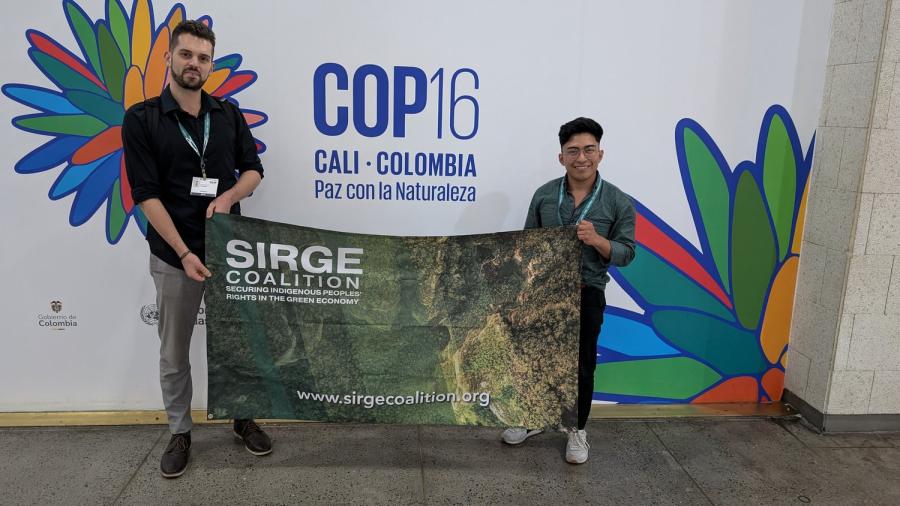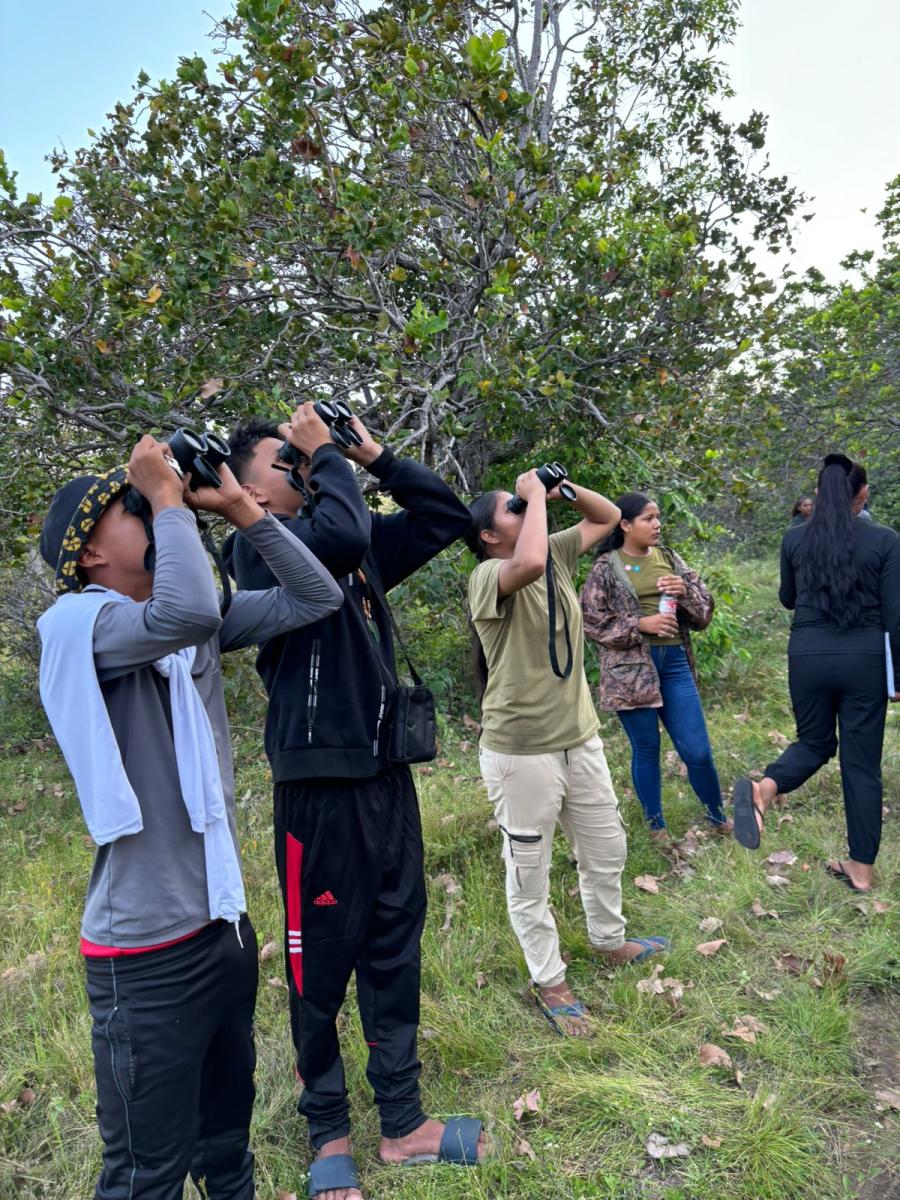
By Shaylin Salas (CHamoru)
My name is Shaylin Salas, and I am a CHamoru woman from Guåhan, Mariana Islands. Guåhan (popularly, Guam) is the southernmost island of the Mariana Islands chain in the western Pacific Ocean. The Indigenous Peoples of this region are the CHamoru and the Refaluwasch communities. In 2022, I was a Cultural Survival Indigenous Youth Arts Fellow. For this, I was invited to attend the 23rd session of the United Nations Permanent Forum on Indigenous Issues in New York in April 2024.
With Cultural Survival’s support, I arrived in New York on April 13 and spent four days attending the forum at the UN Headquarters. The headquarters is a huge complex composed of the Secretariat, the Conference, the General Assembly buildings, and the Dag Hammarskjöld Library. The Forum’s meetings took place throughout the complex, so walking from event to event was often dizzying. The hallways are long, and they turn, curve, and connect to other hallways at intersections that feel far and few in between. In this way, the complex reminded me of the roads of Guåhan. Here, there are only a handful of main roads and one primary highway, Marine Corps Drive. The roads are long, curvy, and only intersect with each other at a few points. So even when you make a wrong turn, if you don’t realize it right away, you may as well keep going because often that is a shorter route than turning around. This is how I felt trying to navigate the 17 acres that are the grounds of the UN. Once I realized I had gone the wrong way, it was often too late, and I just kept on ahead to the next set of hallways that would somehow bring me back to where I was headed.
Guam’s road system, with Marine Corps Drive highlighted in red. Photo source: Wikipedia.
During the Forum, I got to hear incredible and moving stories from Indigenous Okinawans, the Inuit people of the Arctic and subarctic regions of North America, Indigenous folks from Kenya, West Papua, the Philippines, and more. It was special, but also saddening and overwhelming to see and hear these folks share about the deeply rooted struggles of their homelands. If you’d like to read this session’s report on discussed challenges for Indigenous Peoples of the world’s seven regions, you can find it here: https://tinyurl.com/52k2crdx. I found this report useful because it was impossible to catch even half of the meetings and discussions due to the packed schedule of the Forum.
On the third day, I participated in a side event organized by the Ontario Native Women’s Association titled “Collective Solidarity with Indigenous Women and Youth.” It was a discussion about how the Forum could be a more inviting and safe space for Indigenous Women, and it was spectacular. Some suggested changes included allowing longer than three minutes for individual introductions in the formal meetings, creating space for ceremony, and, in general, letting folks be “unapologetically Indigenous.” There seemed to be a consensus that the Forum was not adequately giving room for practices and ways of being that are important to most Indigenous women, Peoples, and cultures. It was well facilitated, and it was clear that the organizers brought pure intentions. However, I couldn’t shake the discomfort in learning that this Forum, even in its 23rd session, wasn’t effectively serving Indigenous women—a population that, by definition, it is meant to serve.
I didn’t know exactly what this Forum was until being invited to attend this year. That’s when I looked it up and found that it is a high-level advisory body to the Economic and Social Council established on July 28, 2000, to do the following:
- Provide expert advice and recommendations on Indigenous issues to the Council, as well as to programs, funds, and agencies of the United Nations, through ECOSOC;
- Raise awareness and promote the integration and coordination of activities related to Indigenous issues within the UN system;
- Prepare and disseminate information on Indigenous issues;
- Promote respect for and full application of the provisions of the UN Declaration on the Rights of Indigenous Peoples and follow up the effectiveness of this Declaration (Art. 42).
These are all important efforts, but based on the language, I wonder if they hold legal weight. What is still sitting heavy with me is the fact that the forum has “permanent” in its title. Something that is permanent is lasting and intended to remain indefinitely. The Forum on Indigenous Issues is permanent… does that mean our issues are also permanent? Lasting indefinitely? As someone who dreams of a world that actively leans into resolution and interdependence, I don’t think it’s all that useful to have a high-level, global political forum on our “permanent issues.” We don’t want permanent issues, we want unifying resolutions, don’t we?
This might come off as nitpicking, but language and how we frame things is very important. For example, also in the title is the subject of the forum: our “issues.” This automatically directs our focus to what is going wrong in our communities and why we don’t deserve to be suffering in such ways. If the subject was our healing or our capacity for solutions, so that the name became The UN Forum on Indigenous Healing or The UN Forum on Indigenous Solutions, how would this affect the direction of the Forum? I can’t say for sure, but I’m certain that it would.
As I reflect on it all, I keep thinking about a talk by Bayo Akomolafe, a philosopher, psychologist, professor, and poet from Western Africa. In 2023, he gave a talk in New England called, “Why We Need Post-Activism Today,” and it really moved me. In it, he suggests that activism and our “politics of inclusion,” as we know and practice it today, might not be what we need anymore. He invites us to reimagine our relationships with each other and the world and to be open to new ways of finding resolution. To illustrate, I included the following statements from his talk,
“Maybe climate matters will not be solved by our rectilinear problem-solving stances. Maybe it will take us bending down. Maybe the only way we rise from this is if we fall together. Maybe it requires a new posture altogether, and then we take a different logic— something outside of the clearing and the wilds. And then we’re able to pose new questions, pose new answers, have new problems together…
A death spiral is a phenomenon that has ants going around in circles because they are in a pheromonic trance. So, somehow the army ants dislodged from the rest of the colony, and they enter into some unfortunate loop, and they just keep going around in circles. The pheromone that they are secreting tells them, just keep on walking, just keep on walking, we are almost there, just a left turn, just another one, just another one. And then they die, exhausted in that circle. They literally die. Another name for that death spiral is ant milling, or ant mills. And I think maybe we are anthro-milling, too.
We are caught up in circles, we are telling ourselves that we are almost there, we are about to arrive… just keep going, you can do it… But then we become veterans quickly in our youth, and then we wonder where we went wrong…
The politics of inclusion is, ‘let’s bring you up to where we are.’ Let’s enforce a paradigm that secretes diversity, equity, and inclusion. Let’s have a language of accommodation. But there’s something about this that leaves me panting for something different…”
Remembering Bayo’s words encourages me to question whether having the Forum every year and focusing on our issues is really the innovative problem solving that we desperately need. A last quote from this talk:
“If I am seen, I can be surveilled, and if I am surveilled then I can be useful, and if I am useful then I am just another part of the furniture of the public order that is premised on my oppression. So, if I want a different politics, then I ought to cultivate bewilderment, I ought to find a way to live with the generosity of invisibility.”
Bayo brings this up to say that although being unseen by “modern society” means being without certain conveniences and privileges, this invisible place is where other sources of power thrive. Other sources like the access to ancestral voices, the opportunity to live in a gift culture, and the joy of sitting with grandmothers that cook and nourish you. While explaining this, he reassures that he is not discounting the value of inclusion politics, for he knows that he benefits from them, too. Without generations-long efforts for more inclusive spaces, he wouldn’t have the opportunity to deliver this talk in this place. He says that his goal is not to criticize inclusion and activism work, but to suggest that moving our global community forward in a radical way— moving out of our ant mills—will require that we try something new.
Thinking about this, I wonder, what if next year, no one went to the Forum? What if we rejected this gesture of inclusion and instead leaned into our other sources of power? What if we organized only among family, friends, and neighbors? What if it turns out that we do our best problem solving sitting under breadfruit trees surrounded by our native songs and loved ones? Or, what if next year, we went but we didn’t talk about our ‘issues?’ What if we only talked about our strengths and capacity for solutions. What if we held each other, healed each other, and showed up only in genuine ways. Would our issues still be permanent then?
I know this article might read as a critique, but my intention is simply to take Bayo’s advice and think about our processes and norms in a different way. I am deeply grateful for Cultural Survival inviting and supporting me to attend the 2024 UN Permanent Forum on Indigenous Issues. The experience changed me, and I will never forget it. I had never seen a more colorful gathering of Indigenous Peoples, and I’ve never heard anything sweeter than the mixing of so many Indigenous languages.
Last but not least, I must mention the immense honor that it was to share the stage with Cultural Survival Fellows Rayen Rapayan (Mapuche) and Kseniia Bolshakova (Dolgan). Cultural Survival organized an Indigenous Media Zone panel discussion for the three of us to talk about our fellowship projects. It was a great privilege to share my work and the stories of my people and to learn the stories of my sisters. Although we didn’t talk much among ourselves because our primary spoken languages were all different, it was obvious to me that these two were warriors. I enjoyed every second I spent with them and I wish them so much love and strength in what lies ahead for them, their communities, and for us all. I don’t know if I’ll ever see Rayen and Kseniia again, as our journeys are scattered in different parts of the globe—or even have the chance to visit the UN Headquarters again—but I know I will forever hold this experience dearly in my heart. Un dangkolu si yu’us ma’åse, a very big thank you to Cultural Survival and to Nati Garcia, Byron Tenesaca, and Georges Dougnon, who made sure that we had all that we needed for the week. And I offer thanks to everything and all that made this trip the unique and wonderful time that it was. Biba!
Top photo: From left to right, Rayen Rapayan (Cultural Survival Fellow), Nati Garcia (Cultural Survival Capacity Building Program Manager), Shaylin Salas, Kseniia Bolshakova (Cultural Survival Fellow). Photo by Cultural Survival.



